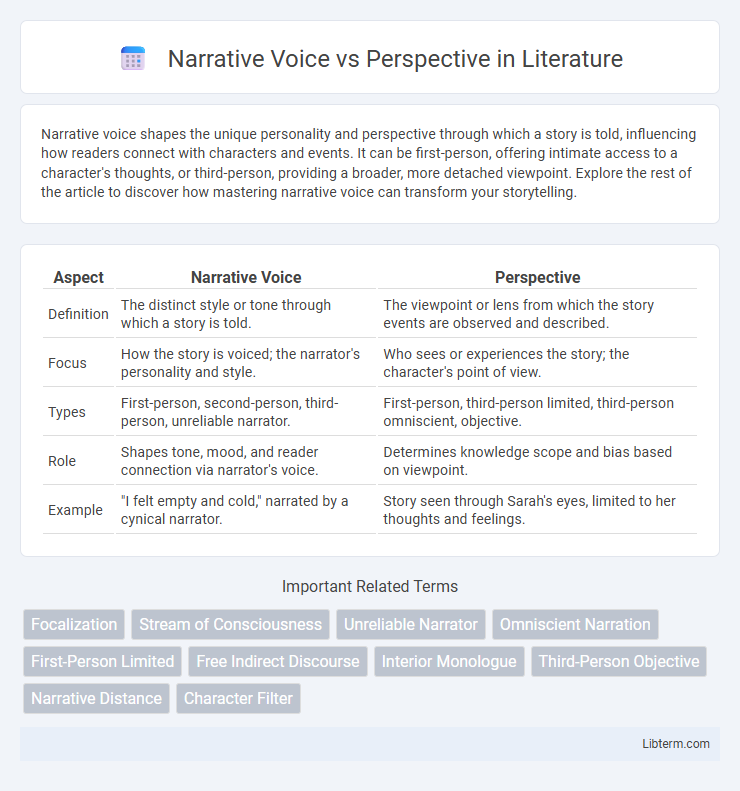Narrative voice shapes the unique personality and perspective through which a story is told, influencing how readers connect with characters and events. It can be first-person, offering intimate access to a character's thoughts, or third-person, providing a broader, more detached viewpoint. Explore the rest of the article to discover how mastering narrative voice can transform your storytelling.
Table of Comparison
| Aspect | Narrative Voice | Perspective |
|---|---|---|
| Definition | The distinct style or tone through which a story is told. | The viewpoint or lens from which the story events are observed and described. |
| Focus | How the story is voiced; the narrator's personality and style. | Who sees or experiences the story; the character's point of view. |
| Types | First-person, second-person, third-person, unreliable narrator. | First-person, third-person limited, third-person omniscient, objective. |
| Role | Shapes tone, mood, and reader connection via narrator's voice. | Determines knowledge scope and bias based on viewpoint. |
| Example | "I felt empty and cold," narrated by a cynical narrator. | Story seen through Sarah's eyes, limited to her thoughts and feelings. |
Understanding Narrative Voice
Narrative voice involves the unique style, tone, and personality conveyed through the storyteller's language, shaping how a story feels and resonates with readers. It is distinct from perspective, which relates to the point of view or vantage point from which the story is told, such as first-person or third-person narration. Understanding narrative voice enhances comprehension of a narrative's emotional depth and authorial intent, making it crucial for analyzing literature and crafting engaging fiction.
Defining Narrative Perspective
Narrative perspective defines the viewpoint from which a story is told, shaping how readers perceive events and characters. It encompasses first-person, second-person, and third-person points of view, each providing distinct levels of insight and engagement. Understanding narrative perspective is crucial for analyzing character reliability and the scope of information revealed in a narrative.
Key Differences Between Voice and Perspective
Narrative voice refers to the distinct style and tone through which a story is conveyed, embodying the narrator's personality and attitude, while perspective denotes the specific point of view from which the events are experienced, such as first-person, third-person, or omniscient. Voice shapes the overall mood and emotional resonance of the narrative, influencing how readers connect with the story, whereas perspective determines the scope of information and insight available to the audience. Understanding the key differences between voice and perspective is crucial for authors aiming to craft compelling narratives that balance subjective expression with the narrative's structural viewpoint.
Types of Narrative Voice
Narrative voice encompasses the unique style and tone through which a story is conveyed, including first-person, second-person, and third-person voices, each shaping how readers experience the narrative. First-person voice allows intimate insights through the protagonist's eyes, while second-person directly addresses the reader, creating immersive engagement. Third-person voice varies between omniscient, limited, and objective perspectives, offering varying degrees of insight into characters' thoughts and events.
Common Narrative Perspectives
Common narrative perspectives include first-person, where the narrator uses "I" and offers an intimate, subjective view, and third-person limited, which centers on one character's experiences and thoughts while maintaining narrative distance. Third-person omniscient provides an all-knowing narrator who reveals multiple characters' internal states and broader context. These perspectives affect how readers engage with the story and understand characters' motivations and emotions.
The Role of Voice in Storytelling
Narrative voice shapes the tone and personality of a story, directly influencing the reader's emotional connection and engagement. Perspective determines the viewpoint from which the story is told, offering unique insights and biases that color the narrative. Together, voice and perspective create a layered storytelling experience that deepens understanding and immersion.
Perspective’s Influence on Reader Experience
Perspective shapes the reader's experience by determining how the story's events and characters are interpreted through specific viewpoints such as first-person, third-person limited, or omniscient narration. This choice influences emotional engagement and the level of insight into characters' thoughts, consequently affecting the reader's connection and understanding. The selective presentation of information through perspective guides readers' sympathies and biases, creating a tailored narrative immersion.
How Authors Blend Voice and Perspective
Authors skillfully blend narrative voice and perspective to create immersive storytelling experiences that deeply engage readers. By aligning the narrative voice--whether first-person, third-person limited, or omniscient--with a distinct character's insight or an overarching viewpoint, writers clarify tone, mood, and emotional depth. This synthesis allows narratives to reflect complex personalities and layered viewpoints, enhancing authenticity and reader connection.
Analyzing Examples from Literature
Narrative voice in literature refers to the distinctive style or tone through which a story is told, while perspective denotes the viewpoint from which the narrative is presented, such as first-person, third-person limited, or omniscient. Analyzing classic works like F. Scott Fitzgerald's "The Great Gatsby," the first-person narrative voice of Nick Carraway shapes readers' understanding, whereas in Jane Austen's "Pride and Prejudice," the third-person limited perspective offers insights into Elizabeth Bennet's thoughts and feelings. Distinguishing narrative voice from perspective enhances interpretation by revealing how authors control information flow and character insight to influence reader engagement.
Choosing the Right Voice and Perspective for Your Story
Selecting the appropriate narrative voice and perspective is crucial for shaping readers' engagement and understanding of your story. First-person narration offers a personal, immersive experience, revealing the protagonist's inner thoughts and emotions, while third-person perspective provides a broader, more versatile view of multiple characters and events. Consider your story's tone, genre, and emotional depth to determine whether an intimate voice or an omniscient outlook best serves your narrative goals.
Narrative Voice Infographic

 libterm.com
libterm.com